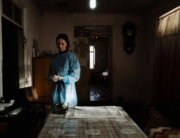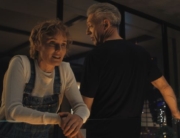The title of this Spanish documentary, Lots of Kids, a Monkey and a Castle, says it all. Julita, the mother of actor-turned-director Gustavo Salmerón, knew early on what she wanted in life: to have many children, and sure enough, she and her husband became the parents of six kids. She also responded to an ad for the sale of a monkey that reportedly ate at the dinner table and liked to wear dresses. This was not actually an example of truth in advertising. After she bought the primate, it was only a temporary member of the household before she gave away the aggressive pet. And while leading a solidly middle-class lifestyle, Julita inherited money—a lot of pesos—enough to buy a medieval castle, ornately furnished, outside of Barcelona.
Salmerón trains his camera squarely at his mother as she holds court. There’s no doubt who rules the roost. She commands her family with a firm hand, dominating any room. Her husband, on the other hand, barely says more than a few words. He’s also hard of hearing, and one gets the impression that he willingly tunes everything out.
At first, there are hints that the director will use his family as a way of searching through the last 80 years of Spanish history. His mother came from a right-wing family, and she says rather defiantly that she is a Falangist, a follower of a fascist party. Yet later on, she declares that the Franco years were terrible, without going further, although her statement seems disproven by her financial windfall.
Julita’s grandmother, according to her, was murdered by communists and buried by a river, the decomposed body going undiscovered years later. Somehow, she kept two of her grandmother’s vertebras, and these remains become the documentary’s equivalent of a MacGuffin as the director and his five siblings dutifully search for these pieces of family history in the parents’ spacious apartment, in which the rooms are stuffed with box after box. (A long-displaced enema and unopened gifts are discovered in one closet.) It’s little wonder that Julita kept and lost those remains. A hoarder, she has a huge warehouse at her disposal, crammed full of what could charitably be called “stuff.” She reasons, “You lose part of your life throwing things out.”
A former nursery school teacher, Julita and her engineer husband led middle-class lives during the 1960s and ’70s, just as Spain was becoming more prosperous and integrated into Europe, and before her grandfather bequeathed her a fortune. But the couple, like a huge number of Spaniards, hit a speed bump in 2008, going broke during the Great Spanish Depression. Julita estimates that she and her husband lost between 22 and 23 million euros and owe one bank seven million euros. The family has little choice but to take stock of the castle and put up armor, paintings, tchotchkes, and the fortress for sale.
But exactly how she came into the money, as well as how the inheritance impacted the family, are just a few of the fuzzy details left in the background. Early on, the octogenarian matriarch looks directly into the camera and tells the filmmaker she doesn’t want him to make this movie, questioning out loud whether or not it would find an audience. (“This is not what people want to see in a film.”) Unfortunately, Salmerón doesn’t really answer or placate her concerns. As such, viewers are left at a distance, as though they are, in fact, watching home videos of strangers. We really don’t learn who these people are, and viewers will only get a glimmer of where this family fits into Spanish society.
The director’s stand-off approach allows his mother to completely take over the film, and she is certainly eccentric. She celebrates Christmas from December through September 15th, puts out the Nativity display in the heat of June, and wants “Silent Night” played at her funeral while her corpse is dressed in a nun’s habit. However, it’s questionable whether there is enough material here for a feature film, or if her eccentricities are enough to hold viewers’ attention for 90 minutes.
Lots of Kids, a Monkey and a Castle screens at the Toronto International Film Festival on September 10, 12, and 15.







Leave A Comment